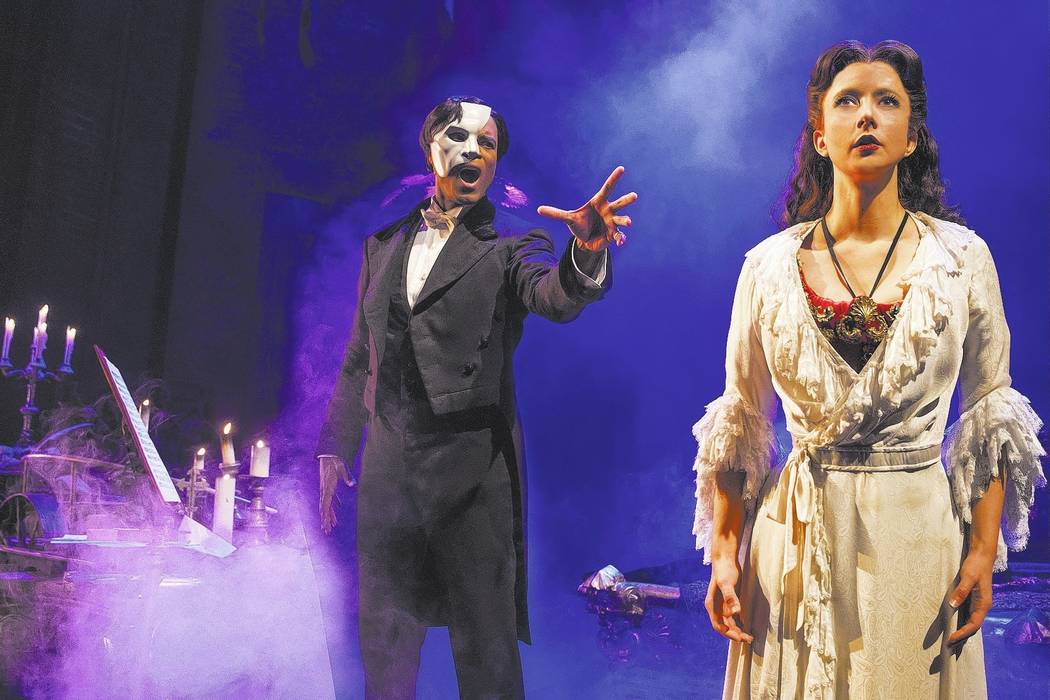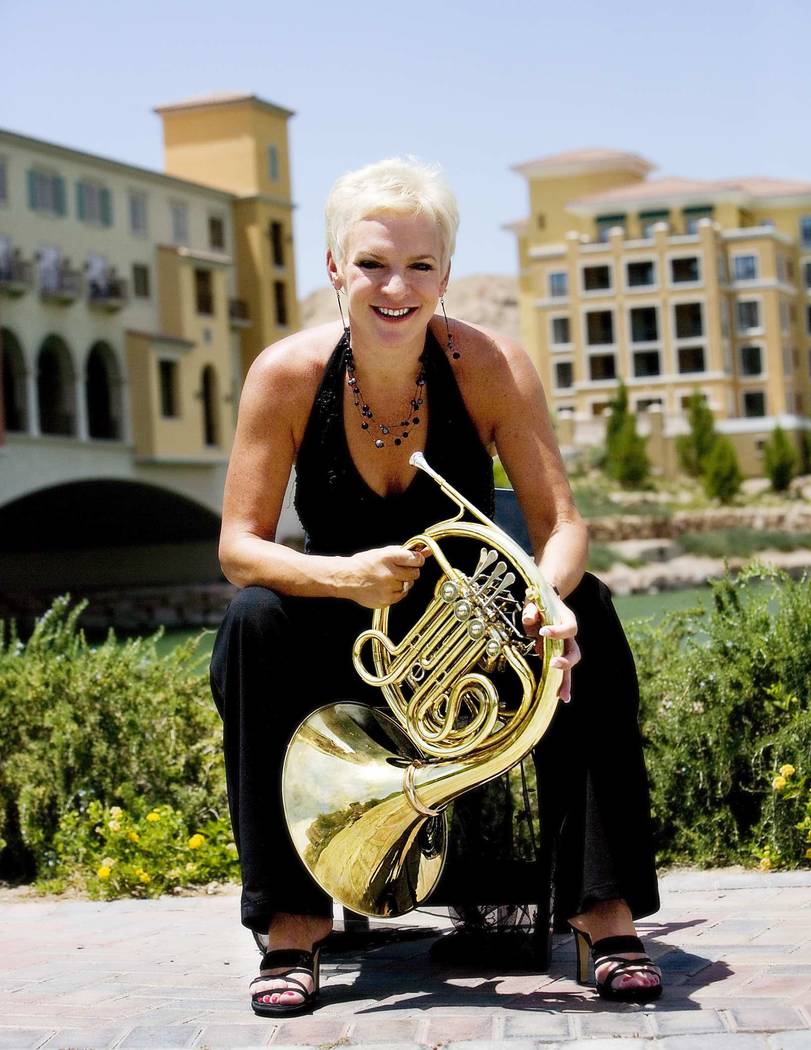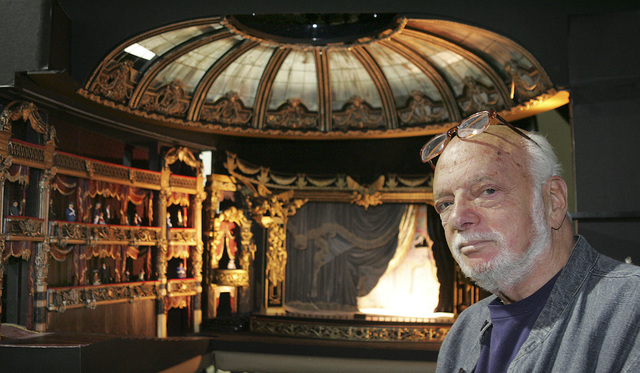French horn player Beth Lano has a connection with ‘complex, beautiful’ ‘Phantom’





One moment former Las Vegas radio host Beth Lano is playing The Who or Metallica. The next she’s playing Andrea Bocelli. I’m not referencing the music that she once played over local airwaves. I’m talking about the stars she’s played for using the French horn she learned to master while playing gospel music in recording studios in Indiana.
This week Beth went from the closing season of The Las Vegas Philharmonic to the 16-performance run of “The Phantom of the Opera,” which opens tonight at The Smith Center for the Performing Arts and continues through June 11.
“When you’re learning to play the French horn and you’re starting to play professionally, one of the best lessons I was ever taught was to be as versatile as I can be,” Beth told me. “Teachers instilled that in me when I grew up playing gospel music in recording studios in Indiana.”
Going from Metallica to The Las Vegas Philharmonic and now “The Phantom of the Opera” is pretty versatile. Is “Phantom” a special piece of music that puts a French horn player through her paces?
It really does. The French horn parts in “Phantom” are so complex and beautiful. There are gorgeous French horn solos throughout “The Phantom of the Opera,” and they’re a challenge to play. But a whole lot of fun, too. I did it for four years at The Venetian. That, of course, was a different version.
Just saying the words “French horn” sounds unusual. Is it unusual as a musical instrument even for musicians?
Other musicians find it extremely daunting because it’s a very difficult instrument technically. The French horn has a huge range from low to high and only the three valves or four, depending on your instrument.
You have to blow through 24 feet of tubing and have your lips at exactly the right place and your air going at just the right time. It’s really easy to miss notes. It’s a very precarious instrument and very exposed.
A bigger challenge for a woman than a man?
It depends on the woman, and it depends on the man. It isn’t a challenge for me. Being a musician is like being an athlete. You have to work out. You have to use your muscles correctly. It’s like a small-muscle athlete. I base my routine on the demands of what I have to play.
Where does “Phantom” figure on a scale of difficulty from 0 to 10?
The version that’s at The Smith Center is about a 9. As you know, “Phantom — The Las Vegas Spectacular” at The Venetian was a shortened version — it was shortened to 90 minutes. This version is the full-length production, and the instrumentation is a little bit different. There are fewer brass players. Instead of using three French horns, there’s one.
They had two trumpets at The Venetian. There are none this time around, so I’m the only brass player in this section. A lot of that will be augmented by a synthesizer, and there’s a full complement of wind players and string players. The concert master and double-bass player from “The Las Vegas Spectacular” will also be there, so it will be a reunion of sorts, as well.
How do you keep playing mistake free and avoid being distracted by the falling chandelier, which is the star of the show?
You really do learn how to focus and tune things like that out. I can’t even tell you how many performances I played with that happening at The Venetian. But, first of all, we won’t be able to see too much of it. The only time it’s a real distraction, and I don’t think that’s an issue with this touring production, is if the chandelier gets stuck.
That happened at The Venetian, but I don’t anticipate that happening at The Smith Center. It’s a different chandelier. The one at The Venetian was specially made for that production, and I’m sure they have one that’s specially made for this one. I can’t wait to see it. It’s going to be really wonderful.
Do you get the opportunity to see it fall during the show?
I won’t because I’ll be playing all 15 performances. It will be interesting during rehearsals. I’m hoping to get up and take a few pictures, but we don’t have the luxury of being able to see the entire production. It’s a little bit odd not seeing everything.
But, again, as a musician you get used to it. If I play, for example, with Tony Bennett or Johnny Mathis, I’m behind the singer. I get to see the show, and I have what I think is the best seat in the house, but I’m not experiencing it the way the audience is.
I’m fascinated that one moment it’s Mathis or Frank Sinatra and Luciano Pavarotti. Who were you performing with just before “Phantom,” and who is after “Phantom”?
I’m associate principal horn in The Las Vegas Philharmonic, so just before “Phantom,” I performed with them also at The Smith Center, which, BTW, what a wonderful asset to our community The Smith Center has been.
It’s always so much fun to play there, and they put a lot of musicians to work, which I really appreciate. I’m playing with The Philharmonic now, “Phantom” after that, and normally I go to L.A. and play if Bocelli plays The Hollywood Bowl in the summertime.
* * *
I chatted with Paul Beard, The Smith Center’s vice president and COO, about our local players who bring so much to The Smith Center shows. He told me: “As a nonprofit, The Smith Center places a strong focus on supporting the highly talented musicians in our own community. We provide ongoing employment opportunities for many local musicians by hiring them to perform in shows at The Smith Center.
“These include touring Broadway shows such as ‘Wicked,’ ‘Billy Elliot,’ ‘Newsies,’ ‘Evita,’ ‘Kinky Boots,’ ‘White Christmas,’ ‘The Phantom of the Opera’ and many more. Local musicians are also often hired to perform backup for prominent artists on our stages, including Johnny Mathis, Kristin Chenoweth, Natalie Merchant and Idina Menzel.”
* * *
How many French horns do you have? As a violinist would treasure a Stradivarius, a horn player treasures her French horn?
I have three, with two always under lock and key for safety. They are definite treasures, especially because my instrument was handmade for me by a wonderful craftsman named Karl Hill in Grand Rapids, Michigan. It was built specifically for me, thus it’s priceless, more valuable than a Stradivarius because to me a Stradivarius would do me absolutely no good.
Las Vegas has to thank Wayne Newton for bringing you to town. Your skill is in memorizing music?
Yes, he brought me to town along with my best friend, then and now, Kim Glennie. She’s a beautiful harpist for The Philharmonic, and we work together on a lot of different gigs. One of my skills — I probably don’t memorize it as well as I used to, but what Wayne would do and I think one of the things that he liked about me was …
Wayne had a skeleton of a show, or he used to, back in the day. So you had that in front of you with a big book of about 500 different pieces of music in alphabetical order right next to your chair. Kim and I were playing his week in Indianapolis, and Wayne would either call up his next tune or not. He’d just start singing it.
After I played it a time or two and it started with a French horn solo, I could remember the solo. I wouldn’t skip a beat, and that surprised him somewhat. So that helped. I do memorize music now, but I was considerably younger then, so I haven’t really had to do that so much these days.
You were also the first female assistant conductor at “Jubilee!” at Bally’s in an all-male band? A fascinating life as a freelance musician. Are there highlights?
Oh, yes. I’ve been so fortunate, Robin. It’s really been a fun life. There are so many highlights. First, playing The Hollywood Bowl with Andrea Bocelli — that was a bucket list item. I’ve always wanted to play there, and it’s just so full of history. You can just feel the spirits of all the fantastic musicians and performers there.
Another highlight was playing the opening of The Smith Center. Now we have some great venues here in town for the format, but, for so long, we didn’t have anything that really would set us on a path to move forward as an entertainment … more than just entertainment, but a cultural force. The Smith Center has changed the landscape for us forever, so that opening night concert was just really a whole lot of fun.
The Smith Center changed it for French horn players, too?
It definitely has. A lot of times when entertainment acts travel, they cut the French horn player because they can’t always find good horn players in the towns they’re in. Now that they know that if they come to Las Vegas, we’ve got … we can furnish them with a full section, no problem. There are very talented horn players here.
If you’d not become a successful French horn player, what would you have been?
A writer. That’s my other life because when you’re a freelance musician, you always have to do other things. I’ve worked for years as a publicist, freelance and in an agency setting. I also write for myself. I write articles, blogs and social media and do all of that stuff — I love writing. You have nothing to worry about, Robin. I’m not trying to take your job as a columnist, believe me!
Back to “Phantom”! Were you with the run of “Phantom” at The Venetian the entire time?
No. I was actually there from late 2008 until it closed. Before that, I played Monty Python’s “Spamalot” at the Wynn. Before that, I was a morning radio show host here for many years. I left my radio job to go back to playing full time.
Steve Wynn didn’t like the fact that he didn’t have a French horn in that show. I got called a couple of days before it opened to come in, and they wrote me a part, and I went in and played it the whole time it was here. That was really a fun job.
What’s the mystique of “Phantom”? Why does it thrill you? Why does it thrill audiences to come and stand and look over the orchestra pit after the show is over?
I believe that “Phantom” is such a great, classic love story and unrequited love and mystery and just a spectacle — the pure spectacle of it all. This could very well be Andrew Lloyd Webber’s best musical. I haven’t worked with this conductor at The Smith Center on this national touring version, but I know he’s arranged the exit music. I’ve heard that he encourages people to stay until the end and listen to the orchestra play it.
There will be surprises in there for the audience. When we were at The Venetian, many times people would wait for us to finish playing the exit music, and they would pay their respects. They would hang over the pit. For a theater experience, it’s a very interactive experience. The musicians are accessible as far as leaning over and saying hello, and we expect and enjoy that.
Not while the show’s going on, obviously, but afterward and during intermission and before the show. It’s always fun to see the kids there, too. The kids come up, and their parents are like, “Look, that’s what your cousin, that’s the instrument your cousin plays.” And these kids, you never know what’s going to turn them on to music and possibly learning it for themselves.
I love the fact that we have The Smith Center. I love the fact that we have great live music, but I never realized that the French horn was such a rare instrument.
It’s a wonderful instrument, and, because of the French horn, I have a very nice life. I’m so fortunate, and I know it every day. I hope that I can keep playing the French horn forever. I hope that I never age out of it. It’s one of those instruments that you can play until you’re old age.
There are horn players who play well into their 80s. It’s like everything else. If you keep your body and your mind healthy, and you keep practicing, hopefully you can just play it as long as it makes you happy.












